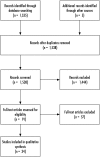A Survey of the Literature on Unintended Consequences Associated with Health Information Technology: 2014-2015
- PMID: 27830227
- PMCID: PMC5171546
- DOI: 10.15265/IY-2016-036
A Survey of the Literature on Unintended Consequences Associated with Health Information Technology: 2014-2015
Abstract
Objective: To summarize recent research on unintended consequences associated with implementation and use of health information technology (health IT). Included in the review are original empirical investigations published in English between 2014 and 2015 that reported unintended effects introduced by adoption of digital interventions. Our analysis focuses on the trends of this steam of research, areas in which unintended consequences have continued to be reported, and common themes that emerge from the findings of these studies.
Method: Most of the papers reviewed were retrieved by searching three literature databases: MEDLINE, Embase, and CINAHL. Two rounds of searches were performed: the first round used more restrictive search terms specific to unintended consequences; the second round lifted the restrictions to include more generic health IT evaluation studies. Each paper was independently screened by at least two authors; differences were resolved through consensus development.
Results: The literature search identified 1,538 papers that were potentially relevant; 34 were deemed meeting our inclusion criteria after screening. Studies described in these 34 papers took place in a wide variety of care areas from emergency departments to ophthalmology clinics. Some papers reflected several previously unreported unintended consequences, such as staff attrition and patients' withholding of information due to privacy and security concerns. A majority of these studies (71%) were quantitative investigations based on analysis of objectively recorded data. Several of them employed longitudinal or time series designs to distinguish between unintended consequences that had only transient impact, versus those that had persisting impact. Most of these unintended consequences resulted in adverse outcomes, even though instances of beneficial impact were also noted. While care areas covered were heterogeneous, over half of the studies were conducted at academic medical centers or teaching hospitals.
Conclusion: Recent studies published in the past two years represent significant advancement of unintended consequences research by seeking to include more types of health IT applications and to quantify the impact using objectively recorded data and longitudinal or time series designs. However, more mixed-methods studies are needed to develop deeper insights into the observed unintended adverse outcomes, including their root causes and remedies. We also encourage future research to go beyond the paradigm of simply describing unintended consequences, and to develop and test solutions that can prevent or minimize their impact.
Keywords: Health Information Technology for Economic and Clinical Health Act; Unintended consequences; electronic health records; health information technology; medical order entry systems; patient safety.
Figures
References
-
- Palmieri PA, Peterson LT, Ford EW. Technological iatrogenesis: new risks force heightened management awareness. J Healthc Risk Manag 2007;27(4):19–24. - PubMed
-
- Koppel R, Metlay JP, Cohen A, Abaluck B, Localio AR, Kimmel SE, et al. Role of computerized physician order entry systems in facilitating medication errors. JAMA 2005;293(10):1197–203. - PubMed
Publication types
MeSH terms
LinkOut - more resources
Full Text Sources
Other Literature Sources
Miscellaneous


